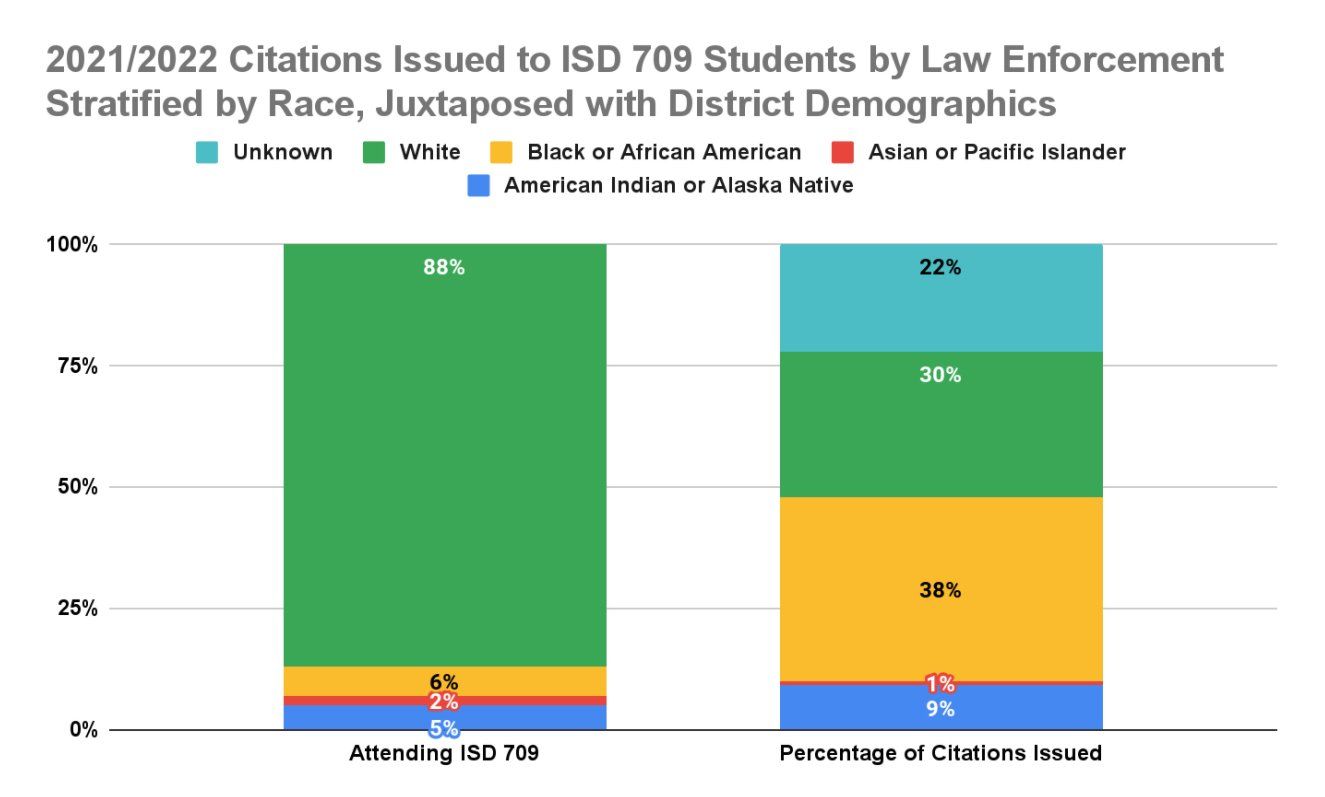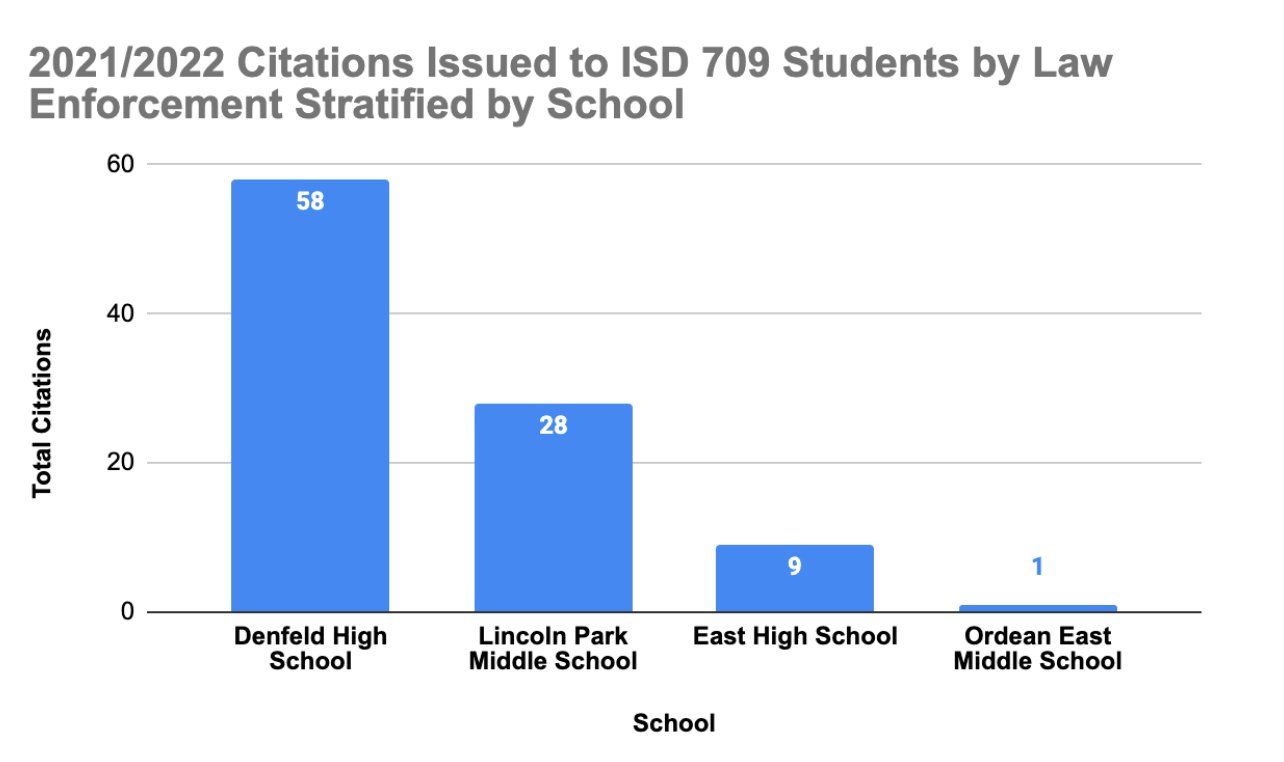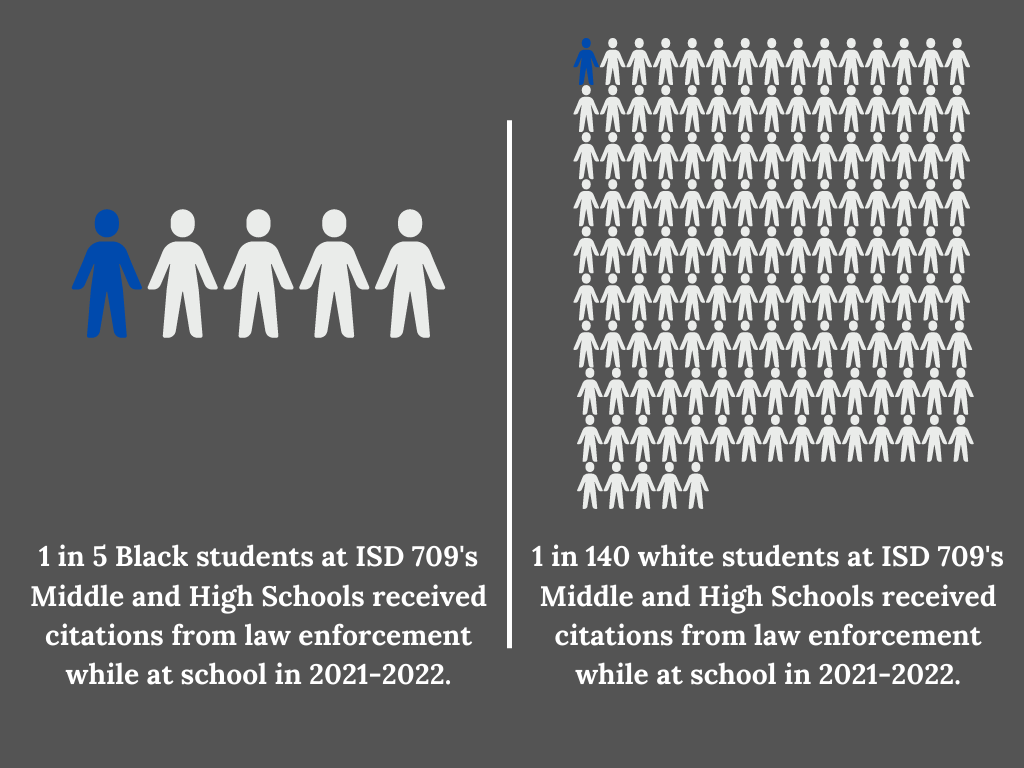Racial Disparities are Evident in Citations Issued to Students at Independent School District 709 in Duluth, MN

Figure 1: 2021/2022 School Year Citations issued to ISD 709 students by law enforcement while at school. Data accounts for 96 incidents that occurred between September 2021 and March 15, 2022. Chart shows percentage of citations issued stratified by race, and is juxtaposed with the racial demographics of the district accessed via ProPublica’s Miseducation Project.
This analysis of citations issued by law enforcement to ISD 709 students while at school was performed with a dataset that contains all citations issued thus far during the 2021/2022 school year, along with the race of the student (Figure 1), the school where the citation occurred (Figure 2), and the type of crime committed. The data was released by ISD 709 to the Duluth NAACP on March 25th, and was subsequently released to the Law Enforcement Accountability Network (LEAN) Duluth for further analysis.
Figure 1 shows that Black students are overrepresented in the citations being issued by officers, making up 38% of citations issued this school year despite only making up 6% of the school district student body. Native American or Alaska Native students are also disparately represented, making up 9% of citations issued despite only making up 5% of the student body.
Figure 1 uses population benchmarking in order to measure racial disparities. The racial make-up of those being ticketed is compared with the overall racial make-up of the school district. This is an appropriate way to measure disparity as it is unlikely that students are being ticketed at schools other than their own and research shows that students should be equally likely to encounter law enforcement no matter their race or school they attend if there were no disparities. In other words, findings from
significant research show that BIPOC students are not inherently more likely to exhibit behavioral problems in school. Thus, a population benchmark disparity analysis is an appropriate way to determine whether BIPOC students are experiencing unnecessarily disparate treatment from ISD 709 and local law enforcement agencies.

Figure 2: 2021/2022 Citations issued to ISD 709 Students by Law Enforcement while at school. Data accounts for 96 incidents that occurred between September 2021 and March 15, 2022. Chart is stratified by the school in which the incident occurred.
Figure 2 shows that Denfeld High School and Lincoln Park Middle School make up the vast majority of citations issued with 58 and 28, respectively. Alternatively, East High School and Ordean East Middle School have 9 and 1 citations, respectively. While apparent disparity exists between the West and East schools, the disparity becomes more extreme when accounting for the fact that significantly more students attend the eastside schools than the westside schools. Using the most up to date school population numbers from the National Center of Education Statistics, citation per student scores can be calculated. Denfeld High School’s citation per student score is 0.062, more than 10 times greater than East High School’s citation per student score of 0.006 while Lincoln Park Middle School’s citation per student score is 0.046, more than 40 times greater than Ordean Middle School’s citation per student score of 0.001.
This analysis shows significant racial and geographic disparities in the issuing of citations by law enforcement within ISD 709 schools. While the reason behind this disparity cannot be inferred from this study, these disparities mirror a larger national conversation about the school to prison pipeline. Limited resources, an outsourcing of discipline to School Resource Officers, explicit and implicit biases amongst educators, and “zero tolerance” policies result in students not getting the help they need, and instead ending up in the hands of the criminal justice system. LEAN’s analysis was superseded in Duluth by a 2018 report put together by ISD 709 students in which students shared disparate discipline data in order to support the removal of police or “School Resource Officers” from their schools.
Additional research is needed in order to further investigate the cause of the apparent racial disparities in this report. While implicit or explicit biases of educators and law enforcement officers might be implicated by this data, further investigation into existing policies must be assessed as well. Furthermore, this study does not quantify the long term damage that increased law enforcement exposure to Black youth creates in the community. How much lost school time and opportunity loss have occurred due to these disparities? How does this exposure to law enforcement at school shape encounters with the criminal justice system later in life? We
strongly encourage community organizations and officials within ISD 709 to ask these
challenging questions with the hope of addressing these disparities in a way that will ultimately
lead to equitable change.
Published April 5th, 2022.
LEAN Performs Further Analysis into School Citation Data; Disparities are Glaring

Since the April 5th, 2022 release of our report that showed glaring racial disparities in citations issued to ISD 709 students by police, the issue has received significant publicity. In addition to media attention and responses from officials at the Duluth Police Department, the City of Duluth, and ISD 709, LEAN has received feedback from local community members. One community member commented:
“...Your data shows the majority of the citations are issued because of fighting and 5th degrees assault. [...] So, these ‘social injustices’ you're making us look at could be just a couple of kids who like to fight and not a major population of children. Your data is skewed to show your agenda.”
As a grassroots data group, we appreciate engagement from fellow community members, especially when engagement provides insight on how we may clarify our work. This email in particular identified a gap in our data analysis. As a result, LEAN requested additional data and performed further analysis on the disparities in citations to account for repeat offenders. The new data finds that the 96 citations issued thus far during the 2021-2022 school year involved 84 students: 73 students received one citation, 10 students received two citations, and 1 student received three citations. Despite making up only 4% of the combined student population at Ordean-East Middle School, Lincoln Park Middle School, East High School, and Denfeld High School,
Black students account for 39% of all students issued citations at those schools.
Taking into account the school populations and the new breakdown of number of citations per student, we are now able to conclude that
1 in 5 Black students in these schools received at least one citation thus far during the school year, while only 1 in 140 white students received a citation. The new data confirms that repeat offenders are minimal and suggest that the racial disparities previously reported in student referrals to law enforcement are systemic.
Over and over again, ISD 709’s disciplinary measures have proven to be disparately punitive depending on the race of the student (Source 1, 2, 3, 4). This data shows that ISD 709 refers Black students to law enforcement at disproportionate levels when compared to their white colleagues, making them increasingly vulnerable to continued conflict, punishment (Source 5), and trauma. In the Duluth News Tribune’s April 10th article (Source 6) Ebony Hilman, co-chair of the Duluth Branch NAACP’s Education Committee, said, “We think that there should be alternatives to SROs in schools…SROs cause more citations and add to the school-to-prison pipeline.” However, the article also includes comments from Assistant Superintendent Anthony Bonds adding: “We have some serious concerns articulated by certain segments of our community, and we also have another segment of our community saying their experiences have been pleasant and they support [it]. So, we’re in a predicament where we have to make a decision on what we believe is best for all.”
There is a need to re-think how conflict in schools is handled, not only after it has occurred but with an eye to prevention as well. What other options can be used before police intervention becomes necessary? Most notably, why is it that an escalation to police intervention happens more frequently for Black children? ISD 709 hosted a
comprehensive strategic planning process on May 16th at AICHO
with dinner and childcare provided in which community members were asked to brainstorm systemwide enhancements to improve outcomes for students. Duluth Branch NAACP President Classie Dudley commented following the event:
“Turnout was high at this event, especially for the BIPOC community. People spoke up, especially against cops in the schools. We are now left wondering, ‘Did they hear us? We turned out and spoke up, but what will ISD 709 do now that they know what we want?’ I hope that the BIPOC community, whose kids are most negatively affected by these policies, are valued when determining these next steps.”
Sources:
- https://medium.com/duluth-now/the-disturbing-racial-disparities-in-how-duluth-public-schools-discipline-students-35c99f676f49
- https://www.duluthnewstribune.com/news/discipline-disparity-in-duluth-schools
- https://www.startribune.com/minnesota-school-districts-grapple-with-discipline-disparities/494043261/
- https://www.startribune.com/minnesota-school-districts-grapple-with-discipline-disparities/494043261/
- https://projects.propublica.org/miseducation/district/2711040#:~:text=Discipline&text=Black%20students%20are%207.2%20times,student%20suspensions%20is%20not%20available.
- https://www.duluthnewstribune.com/news/local/duluth-school-district-considers-changes-to-police-contract
Published May 18th, 2022.